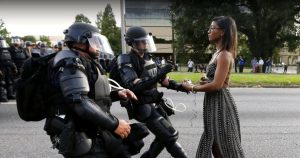
The Bistro
Public Dining Room
Public Dining Room
Active 2 years ago
Please step in to our grandest dining room for your Lace on Race Café dining experience. We are… View more
Public Dining Room
Group Description
Please step in to our grandest dining room for your Lace on Race Café dining experience. We are committed to serving you kind candor with love and with care. We will walk with you, encounter you eye-to-eye, and nourish your resilience and reliability in the realm of racial equity as we look to our North Star: Lessening and mitigating the harm endured by Black and brown people, perpetuated by white people and white supremacy. Welcome, and please enjoy.
Black History Month at LoR: Honoring leshia Evans
-
CreatorDiscussion
-
February 7, 2021 at 8:58 pm #6950

Lace WatkinsKeymasterBe honest, you’ve probably seen her picture, but… did you ever even know her name? Do you know what she was doing in the days before she became an icon? Do you know where she spent that night? Have you heard about her since?
Ieshia Evans makes a beautiful, statuesque, moment in time. But she is also a woman, breathing air, living life. Living life as a strong, proud, Black woman, only accidentally famous.
What can we learn about her and from her and from our knowledge of her and perception of her?
How do we honor her?

-
CreatorDiscussion
-
AuthorReplies
-
February 7, 2021 at 9:28 pm #6955

Vicki van den EikhofOrganizerThis seeing people as a complete, living, breathing person is the reason I love the LoR approach. And it says something that I never knew her name until now.
There is a bit of information out there about her. She was 35 at the time of this photo. The police arrested her and held her overnight (about 24 hours). She is a nurse. Born in Brooklyn.
I find that I have to resist the urge to make her into an icon that represents a movement. There is a case to be made for that, but that’s not what Lace is asking for. I’m really having to work to see her as a person, not an image. Reducing people to a caricature, or just some kind of representation of who they really are is something I find myself doing a lot. If I can reduce someone into a two-dimensional figure, I can create a foil for my own arguments. I can fight against shadows and win. But when I see people as complete humans, with lives and hearts and loves and losses, it’s much harder to fight them. They are not shadows. (Cross-posted from FB)
-
February 14, 2021 at 9:38 pm #7312

Kelsi WattersMemberVicki I like what you shared here. It sometimes can be tempting to either reduce someone into an icon or put them on a pedestal. As you said, this gives us the power to shape that person according to what makes us comfortable or suits our needs. Embracing the full reality of who a person truly is means accepting all of them, even (and maybe especially) the parts of them that make us uncomfortable. That seems like an act of hesed love.
-
-
February 7, 2021 at 10:08 pm #6957

Rebecca McClintonMemberI have seen her picture, and did not know her name nor that she was a nurse, mother, and spent the night in jail after.
In an article I read, Ieshia said, <font size=”4″>“I’m not against protesting peacefully, and I’m not pro-violence, but I’m definitely in favor of defending yourself. When people hear the way I speak, they’re usually like, ‘uhh, this is not what I thought. We thought you were just about peace and holding hands!’…</font>“I think I will be remembered as a peaceful protester who saw injustice going on and took a stand,” she said. “I’d like <font face=”ProximaNova, Helvetica Neue, Helvetica, Roboto, Arial, sans-serif” size=”4″>to be remembered as a revolutionary.” I honor her as that. </font>
One thing that stood out to me is how as a nurse getting arrested she likely had to report the arrest to the state department her license is through and could have been put on leave for a while, depending. Often one arrest can tarnish your license and make change in employment difficult. She also has used her notoriety to speak out in other ways (ways that have challenged the motif of ‘peacefully holding hands’). That’s revolutionary too.
(crossposted to facebook)
-
February 8, 2021 at 3:14 pm #6964

Deleted UserMemberI’ve never seen this picture or heard of this woman but I did hear about the furore about the Kardashians Pepsi ad, which I assume was based upon this scene?
.
I did some Googling but didn’t find much other than she is a nurse arrested at a protest and spent the night in jail.
.
She is just like the rest of us showing up at a protest, taking to the streets because we’ve all had enough, that something needs to be done, people need to listen. Everyday people, with everyday lives becoming active and mobilised.
.
Frozen in time, this harmless woman with bare arms and a flowing skirt, she looks like shes off to the beach and she’s up against a raft of overdonned, over weaponized police men eagerly getting ready to throw her in jail.
What can I learn from her? How do I honour her? Be willing to stand up and be counted for what I believe is right. Walk with integrity and conviction.
-
February 10, 2021 at 9:58 pm #7070

Emily HolzknechtMemberI see where you’re going with her being like the rest of us showing up at a protest and at the same time, I’ve never traveled across the country to go to a protest. Yes, many white women did travel across the country for the women’s march, but Ieshia Evans traveled across the country to a protest because she wanted to show she had done everything she could for her Black son because she saw his future in these Black men being targeted with violence by police. The white women who went to the women’s march did not go there to protect their son’s from being killed by police. She also said that she stood there in front of the police in riot gear because God was working through her which to me connects her to the Black theology part of the Civil Rights movement, so I think that also makes her different than a lot of us who show up at protests.
-
February 17, 2021 at 12:59 pm #7460

Deleted UserMemberHi Emily. Just wondering on your comment, do you think that white people/women don’t travel the country to protest for others? I can’t comment on God and Black theology but appears that when you’re referring to white women here, you speak of them in terms of only going to marches that benefit themselves. I was just curious on that.
-
February 17, 2021 at 1:28 pm #7461

Emily HolzknechtMemberThank you for asking.
I imagine that many white women who went to women’s marches, whether they traveled significant distances or not, would say that they went for their daughters, though perhaps not so much because this is a life or death situation for their daughters? When the first women’s march happened and the others that happened that year, I was thinking in part of my daughter and the fact that she will deal with sexism and rape culture, but I do not see her life at risk the way that, say the lives of native women are at risk or the way that Evans sees her son’s life being at risk.
What I was hearing in 2016, 2017 and more recently from Black activists was that all those white women who showed up at the Women’s March are unlikely to show up for BLM protests and that includes BLM protests in their own areas. I know that has been the case locally in Albuquerque. The Women’s Rally (it wasn’t a march here) here was a much bigger event than the local BLM protests have been. I am sure that more white women traveled to go to BLM protests in 2020 than in previous years, but I am thinking that it was still not at Women’s March levels. Just from my own circles, with the Women’s March there were people talking about going to DC for that one and photos of them there in DC for it. There were people posting pictures of making hats and signs. There were people posting pictures afterwards of themselves there. I have seen none of that for white people and any BLM protests in my circles. Did they go and never speak of it like how Lace says we treat LOR like pornography? Did they go and never speak of it because of some sort of respect? I think that’s giving too much credit to think it’s one of those things. Blak activists are right and white women mostly show up for themselves and when there is no risk to themselves.
-
February 26, 2021 at 2:36 am #8139

Deleted UserMemberThank you for the clarification. Those figures are interesting. I agree it’s easy for people to turn away when they feel something doesn’t directly affect them. Like you say, ww only getting out of bed for themselves.
-
February 26, 2021 at 5:54 am #8140

Lace WatkinsOrganizerQuietly, as a group, white women won’t go across town for racial Justice. Think about the block spring of last year. Here in San Diego, at least initially there was a sprinkling of white faces in some of the protests but that dissipated quickly, in fact one could say that the reason the black spring didn’t turn into the black year was because of the fickle interest of white people. About five years ago, in 2016, a black man was killed in El Cajon, a suburb east of San Diego. There were protests for a month, until the district attorney decided that they were not going to press charges against the officer who killed Alfred olango. I remember going the very first week and seeing out of about 2000 people maybe about 10 white people, five of home I knew. No, what people do not show up for racial Justice and when they do they do it once. Thoughts?
-
February 28, 2021 at 2:58 pm #8246

Deleted UserMemberHazarding a guess. The system has everyone so distracted that they don’t get enough time to pay real attention to what is going on around them. People are generally disengaged, feel a bit helpless and don’t have the spoons or time to really engage to any great depth. And, if they do engage at all, it’s never consistent. I don’t think that’s specific to racial justice, I think that perhaps goes for most things. The system relies on it. What about you Lace? What’s your thoughts?
-
-
-
February 9, 2021 at 12:15 am #6988

Grace BannermanMember<font color=”#000000″>If I ever knew Ieshia Evans’ name, I had forgotten it. I recognized the image from one of the Black Lives Matter protests in the USA, but I wasn’t sure which one or when.</font>
<font color=”#000000″>With this prompt, I learned her name and that she was presumably working as a licensed practical nurse and caring for her son in the days before the photo. I forgot or never knew that she was arrested shortly after the photograph was taken and spent the night in jail. I am more aware now of how she took part in civil disobedience in a considered way because she thought it was right. I don’t think I heard about Ieshia since 2016. </font>
<font color=”#000000″>My perception of her before this shows that I appreciated the photo as a symbol, but I did not take the time to learn about Ieshia as an actual person, or to learn from her – admiration without action, mistaking feelings or social capital for meaningful work. Seeing this picture as a symbol or historic distanced me from learning what Ieshia stands for and how to support that or emulate her. Some of the news articles about the protest in which the photo was described and discussed more than Ieshia or her motivation/message did the same, and reading them demonstrated how lacking that approach is.</font>
<font color=”#000000″>Ieshia reminds me of the importance of looking beyond images and seeing Black people as complex human beings, as well as going out of one’s way to do the right thing. Doing those things would be good ways to honour her. </font>
-
February 9, 2021 at 6:09 pm #7014

Rhonda FreemanOrganizerI learned she inspired a poem by another black and woman and I am blessed by it. The poet’s name is Tracy K. Smith.
“Unrest in Baton Rouge”
after the photo by Jonathan BachmanOur bodies run with ink dark blood. Or else
It pools in the pavement’s seams.Is it strange to say love is a language
Few practice, but all, or near all speak?Even the men in black armor, the ones
Jangling handcuffs and keys, what elseAre they so buffered against, if not love’s blade
Sizing up the heart’s familiar meat?We watch and grieve. We sleep, stir, eat.
Love: the heart sliced open, gutted, clean.Love: naked almost in the everlasting street,
Skirt lifted by a different kind of breeze-
February 10, 2021 at 9:03 pm #7068

Emily HolzknechtMemberCan you tell me more about what you mean when you say “I am blessed by it”?
-
-
February 10, 2021 at 9:01 pm #7067

Emily HolzknechtMemberI don’t know if I read her name at the time. I certainly couldn’t have told you it before this post.
Important questions I should have been asking when I first saw the picture right after it was published: What is her name? Did she get arrested? What are the organizations I could have been contributing to that were paying for bail for people at that protest? Who is she when she isn’t in this photo? What did this moment mean to her rather than what it means to me?
Reading the article about her 2 years since the picture was taken, I can see that we can honor her by assertively fighting for change and by whistleblowing. Those are the things she identified as wanting to see more of and not just by people like her.
As others have said, I learned that she is a nurse and a mother and that she went for her son, so that she can look him in the eye and tell him she did everything she could do. I also read that she said that her standing in front of those officers in full riot gear was an act of God. That is a reminder that the ongoing civil rights movement – hundreds of years long – has a deep connection to religion that must be honored.
-
February 10, 2021 at 9:13 pm #7069

Emily HolzknechtMemberTo answer the other questions asked: I do not know what she was doing in the days before the photograph. After reading I am guessing that she was working as a nurse, she was caring for her son, she was traveling across the country to Louisiana. I had not heard about her since.
My perception about her before reading about her and probably also after reading about her was informed by a lifetime of hearing white people speak to a value of nonviolence though not necessarily employing it themselves and also all the examples of nonviolence I can think of from the stories presented to me in my life were of nonwhite people engaging in nonviolence suggesting that white people value non violence… in nonwhite people. We have seen that nonviolence can lead to change, but realistically that is not why white people like nonviolence. We like it (or claim to like it) when we get to remain comfortable. We like it because it seems safe. We like it until we feel uncomfortable about it like when a Black man kneels at a football game and then we don’t like it anymore. Because my perception about her is informed thusly, I assumed that she thinks nonviolence is the way. But I have read that she does not think that. She is not against nonviolence and she is not for violence, but she is for people defending themselves which could be nonviolent or violent.
-
-
February 14, 2021 at 9:29 pm #7311

Kelsi WattersMemberI was reading an article about Ieshia Evans and how she became an icon. The article talked about the photo that was taken of her being arrested as she stood before the Baton Rouge police station protest the shooting deaths of Philando Castile and Alton Sterling. Evans was described as having her feet planted, with a stoic gaze and perfect posture that showed her determination and resolve. The photo went viral, and quickly turned her into an icon for the Black Lives Matter movement. As we have talked about in other discussions here in the Bistro, it seems that when someone becomes an icon, especially a moral icon, their vision, image, and story become distorted into whatever suits the majority. MLK’s image and vision gets somewhat distorted because most of us only know the parts of him that are palatable and comfortable to white people. After this photo, many people chose to view Ieshia Evans as a peaceful protester, someone who was “all about holding hands”. Following her arrest, she began to be more outspoken about her political viewpoints. I imagine people experienced a great deal of dissonance as they realized her actual beliefs were not in alignment with the iconic version of her that was portrayed.
Evans said, “I’ve had people who see the picture, and they get this idea in their head of who they want me to be. And then they get a glimpse of who I actually am, they don’t like it.”
That is a core element of white supremacy. People of whiteness did not like who she was because her belief in direct action made them uncomfortable. Given the photo description, it’s understandable how people would look at it and view her as a peaceful protester. However, the part that is harmful, is rejecting who she is because it makes us uncomfortable, and morphing her (iconic self) into something that is palatable, something that allows us to continue perpetuating cycles of harm without being challenged. When a black person becomes an icon, whitness and white supremacy hold the power to morph that icon into whatever challenges us the least. To truly seeEvansfor what she was, an ordinary black woman who is a mother, a nurse, and a citizen who recognizes the flaws in both political parties and in law enforcement, who believes in defending herself and her people – would be too challenging and uncomfortable in the face of white supremacy.
-
AuthorReplies
Log in to reply.